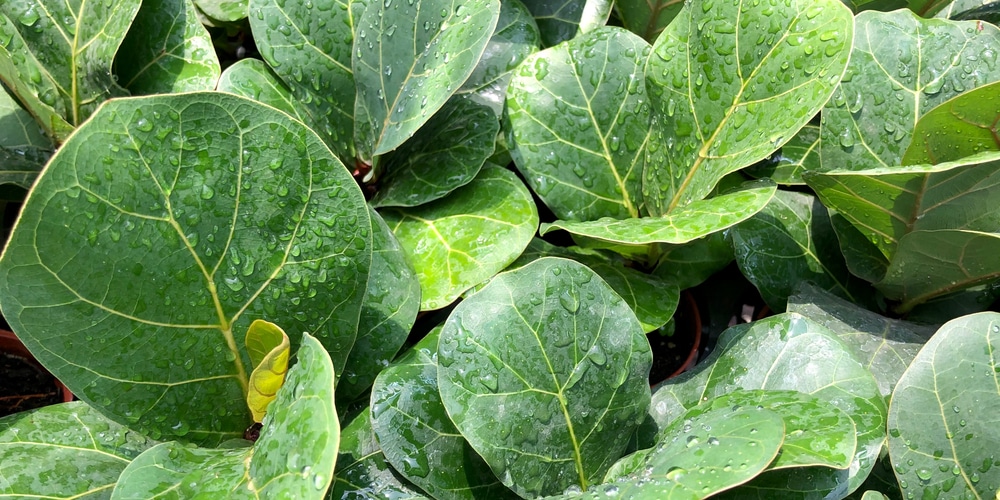Fig trees come from Mediterranean climates. So, most of them like warm, dry summers and cold, wet winters—think warm golden sunshine and dark blue skies turning into chilly breezes and grey skies. And unlike tropical plants, they are not evergreen all year round.
Why are my fig tree leaves turning yellow? Fig trees are deciduous trees. So, they go through a period of dormancy in the mid to late fall, which is why growers need to differentiate the old wood from the new growth of the fig tree.
Yellow leaves appear because these plants need to lose all of their leaves, just like oak trees and maple trees do. Not because of frost or freezing temperature, but because the sun gets less intense by the day.
Only in rare cases do fig trees’ leaves yellow for other reasons.
When A Fig Tree Loses Its Leaves
Before you can fix any micronutrient deficiency that may cause a fig leaf to turn yellow, you should know what happens when the leaves naturally fall off a fig tree. Yellow leaves usually wither, shrink, and turn brown before falling off. For clarity, they do not look pretty nor turn red or orange.
While the fig tree leaves might seem to fall apart and show brown crumbly spots or rust, the tree is not sick. The plant is just going through a necessary process, leaving its foliage to fall off during the wintertime rest period.
During fall, this process is critical for later fruit production. For this reason, you should not fertilize your fig trees before winter.
If you grow your figs in containers, do not bring them inside and put them under a grow light. Doing nothing that could alter this natural process is imperative if you want tasty fruits in the next season.
How Do I Fix Yellow Leaves On My Potted Fig Tree?
If you do not prepare a well-draining soil mix for your potted fig trees, the soil can get waterlogged. Root rot can ensue shortly after, causing the fig tree yellow leaves issue. In this case, some leaves will become completely yellow, and you need to act fast.
In their natural habitat, fig trees develop shallow roots because of the dry soil conditions. So, it is easy to saturate a container with water if you only examine the topsoil layer. For more precise readings, using a moisture meter is recommendable.
Follow these steps to try and save your potted fruit plant:
- Remove the plant from its container.
- Loosen and wash off the old soil from the roots—also, inspect the roots for mushy areas which may show it is too late.
- Use a combination of organic potting mix, perlite, and compost to add organic matter to the mix and improve drainage.
- Keep the plant one inch below the rim of the new container before filling the pot at the sides. Consider drilling bigger drainage holes as an option. Also, sterilize your container with bleach if you do not change the container.
Macronutrient Deficiencies Causing Yellow Fig Leaves
If your fig tree is not going through the lignification process, yellow fig leaves may appear because of a macronutrient deficiency. In this case, the solution might be harder than you might think. But let us take one step at a time and try to understand what the problem might really be.
The five chief causes of macronutrient deficiencies are a lack of:
- Calcium
- Magnesium
- Nitrogen
- Phosphorus
- Potassium
Every deficiency leads to different visible signs, including yellowing and other contributing factors. For example, a Potassium deficiency also induces chlorosis, which means blanching. Plus, it causes necrosis at the edges.
Nutrient imbalances can happen for a variety of reasons. In most DIY contexts, it is because of an excess of nutrients that stops your fig tree from reaching its full potential. It can also lead to contamination, pathogens, and nitrates in drinking water.
Most figs only deplete the soil of Nitrogen, Potassium, and Phosphorus. But occasionally, they might manifest symptoms of other deficiencies. Of course, this does not mean that the soil is depleted yet.
Why? Because if you add too much of a macronutrient, you might change the soil pH or structure, making it impossible for the plant to absorb other vital minerals.
Improving soil health is possible. But before you can improve it, you have to perform a few soil tests. You can then use a fertilizer or soil amendment to improve your figs health.
Related Article: Can I Put My Fiddle Leaf Fig Outside in Summer?

